Abstract
The aim of the study was to analyze the characters’ reception of the American series Lost, whose performances ranged from American, Latino, European, Korean, Russian, Arabic, Australian and African; men and women, children, youth, adults and seniors. Five focus groups were carried out with 29 young people who lived in Monterrey, Mexico. In order to interpret the results, we used the model of Palmer and Hafen, in the extended version of Inzunza-Acedo, and the types of empathy of Igartua and Muñiz. The findings point to a trend of acceptance or rejection of such naive characters, since there is no critical reflection about the stereotypes, due to either the emotional attachment by the spectators or to humorous elements of the script.
Barker, C. (2003) Televisión, globalización e identidades culturales. Barcelona: Paidós Comunicación.
El País. (2010, mayo 24). ¿Cuál ha sido tu personaje favorito de Perdidos? Madrid, España. Fiske, J. (1999) Television culture. Londres: Methuen & Co. Ltd.
Hall, S. (1980) Encoding/Decoding. En S. Hall, A. Lowe y P. Willis (Eds.) Culture, Media, Language. Londres: Hutchinson. 117-127.
Igartua, J., & Muñiz, C. (2008). Identificación con los personajes y disfrute ante largometrajes de ficción. Una investigación empírica. Comunicación y Sociedad, 21(1), 25-52.
Inzunza Acedo, B. (2012). Lecturas de aceptación y de rechazo de la serie norteamericana “Lost” entre jóvenes de Monterrey, México. Global Media Journal México. Recuperado de http://www.gmjei.com/journal/index.php/ GMJ_EI/article/view/348/278
Nielsen Media Research, Inc. (2008). Nielsen TV Ratings Data: Lost. Recuperado de http:// tvbythenumbers.zap2it.com/2008/05/30/losts-lost-viewers/3978/
Orozco, G. (1987). Televisión y producción de significados. Guadalajara: Universidad de Guadalajara.
O’Sullivan, T., Hartley, J., Saunders, D., et al. (1998). Key concepts in communication and cultural studies. Londres: Routledge.
Palmer, A. & Hafen, T. (1999). American TV through the eyes of german teenagers. En Y. Kamalipour (Ed.) Images of the US around the world. A multicultural perspective (pp. 135-146) Nueva York: State University of New York.
Park, J., Gabbadon, N., & Chernin, A. (2006). Naturalizing racial differences through comedy: Asian, Black and White views on racial stereotypes in Rush Hour 2. Journal of Communication, 56, 157-177. Recuperado de http://www.rci.rutgers.edu/~waltonj/404_rr/rush%20hour%20two%20stereotypes.pdf
Pearson, R. (2009). Chain of events. En R. Pearson, Reading Lost (pp.139-159). Londres: I.B. Tauris.
Pickering, M. (2001). Stereotyping. The politics of representation. Nueva York: Palgrave.
This journal is registered under a Creative Commons Attribution 4.0 International Public License. Thus, this work may be reproduced, distributed, and publicly shared in digital format, as long as the names of the authors and Pontificia Universidad Javeriana are acknowledged. Others are allowed to quote, adapt, transform, auto-archive, republish, and create based on this material, for any purpose (even commercial ones), provided the authorship is duly acknowledged, a link to the original work is provided, and it is specified if changes have been made. Pontificia Universidad Javeriana does not hold the rights of published works and the authors are solely responsible for the contents of their works; they keep the moral, intellectual, privacy, and publicity rights.
Approving the intervention of the work (review, copy-editing, translation, layout) and the following outreach, are granted through an use license and not through an assignment of rights. This means the journal and Pontificia Universidad Javeriana cannot be held responsible for any ethical malpractice by the authors. As a consequence of the protection granted by the use license, the journal is not required to publish recantations or modify information already published, unless the errata stems from the editorial management process. Publishing contents in this journal does not generate royalties for contributors.


